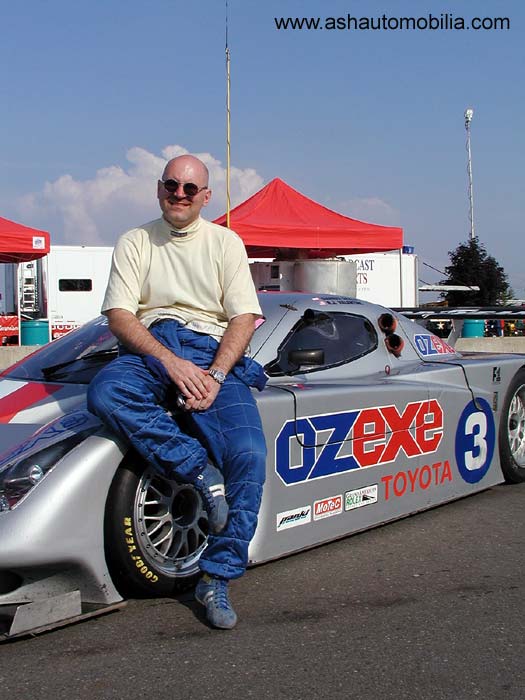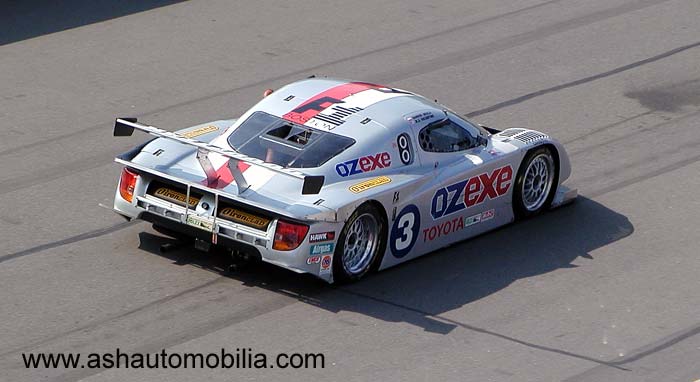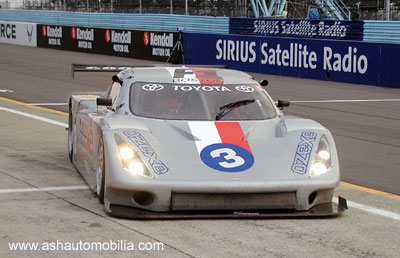Talking With Darius Grala – Cegwa Sports In Grand-Am
© Andrew S. Hartwell
During the Grand-Am Rolex Series weekend at Watkins Glen, we spent
some time getting to know Darius Grala, one of the competitors running a
Daytona Prototype. A resident of Weston, Massachusetts, Grala was the
2002 Ferrari Challenge Champion and a former racer in the ACRL before
purchasing a Fabcar-Toyota chassis from Dave Klym’s Fabcar Engineering.
His car is just one of three Fabcar chassis currently on the track, the other
two belonging to Brumos Porsche.
Grala is very upbeat about his place in racing today. That is, his place on
the ‘ground floor’ of the new Daytona Prototypes series.
“I love it! I absolutely love it! I mean... it’s been tough getting started. We are
a new team and I’m new to this series. Yeah, I know the class is new for everybody, but I think the youngest team here is at least 10 years old. They have been together racing faster cars, you know prototypes, but to us this is all new.”
Grala chose his team name carefully, and with an eye to the past. The team is known as Cegwa Sport. The term Cegwa was used to honor his father.
“In Polish, the word Cegwa means ‘brick’. Now I know some people would say we have been something of a brick this year so far, but my dad was a mason back in Poland, where I was born. The name Cegwa was chosen as a tribute to him. He died when I was 19.
“We were looking for something different, and clever. I actually had a company called Cegwa Corporation. So it just kind of seemed natural to go with that name. The company still exists it is just now, mostly, a racing company at this point, running this team.”
With so many of today’s hot shoes pointing to an early start in karts and years spent developing their skills on the race track, we naturally assumed this was the case with Grala as well. We were mistaken.
“I started racing in 1999 in a series called Sports Toyota. I was 29 when I started. I’m sad to report that I didn’t grow up wealthy. I wish I did, but I didn’t. All I ever wanted to do since I was six years old was race cars. In my eighth grade yearbook my favorite hero was Mario Andretti and my favorite book was about karting.
“My parents were not wealthy by any stretch of the imagination. We were the classic immigrant story. We came here with nothing. When my dad died it was even a bit tougher. I was in college at the time, so I couldn’t really start racing until I got out of school and got a real job and saved some money. Then I went to Skip Barber’s school and then eventually, in 1999, I began racing full time in Sports Toyota. In 2002 I raced in the Ferrari Challenge and I won the championship.
“After that, it didn’t seem like it made sense for me to keep racing in the Ferrari Challenge as I wanted to race at a top level. I think I’m probably behind the eight ball - well that would be an understatement – in terms of talent and experience compared to the other guys, but I am not afraid of a good challenge.
“I don’t have a mentor or coach. I’ve worked with a few folks, and god knows I could use as much help as anyone is willing to give me. But I’ve always gone for coaching when I feel I need it. Right now I feel I know what my limitations are and what I need to do. (Laughing)
“I take little bites at it every weekend. It’s a steep learning curve. For me, I’m an Engineer by trade so I wasn’t as interested in having a pro set up the car for me and then have me just go out and race it. I actually want to learn how to set up the car properly myself. And this series has some things that I didn’t have in the other series.
“I didn’t have adjustable shocks, so they are new to me. I also didn’t have anywhere near this much aero control and what I can do. In the Ferrari Challenge you can control the tunnels a little bit by changing the rake of the car but we didn’t have a wing. In the Sports Toyota we had a wing but it wasn’t really the same. It was a good little car to learn on but this is certainly the best challenge I’ve had to date.”
Throughout our conversation Grala had a ready smile that often punctuated his remarks. He is really enamored of the game at this level of competition.
“This is just great. I love the fact that we can do so much to the car. Obviously we are not the fastest car here yet but every time we get out we learn something new. The team is not purely manufactured for the purpose of winning, although that is our expectation eventually. For now it’s just all my favorite guys I have met in racing – from all the various teams – working on our team. Luckily all of the guys I invited to join Cegwa said yes.
“We are having a great time. The cars are great and fun to drive. At the start we had probably a little bit more of a challenge than I would have liked with the early development phase of the motor, because it was new, but I think we’ve got it all worked out now. By far, what we have now is the best we have had all season long.”
Grand-Am was hoping to get a fast start on the new DP concept in 2003. The premier event, the Rolex 24 Hours of Daytona, was to be the place to introduce several new cars. Officials were looking to get as many new cars on the grid as possible. Some, like the Bell Motorsports Doran-Chevy, were obviously making an appearance a bit prematurely. But it is doubtful anyone got to Daytona any closer to race date, or with less track time, than did Cegwa.
“Daytona was our first race. For the first test at Daytona (in January) we literally picked up the car at the Fabcar facility in Indiana and drove straight through to the track. The car didn’t even have a lap in the parking lot. And we were so busy changing things around, because the car was originally designed to take a Porsche motor – so it was a lot of tweaking. As Dave Klym put it, the car was not ready to race, it was ready to test.”
When it was suggested that his team might develop a reputation for being the guys having too much fun, and perhaps not be considered a serious effort, Grala replied:
“I can definitely tell you that in this series, we are working with the smallest budget, we are working the hardest, and we are having the most fun. We are working on the money part. We have about 15 to 20 things that look really promising but I have nothing definite that I can tell you. That isn’t going to keep us from racing it’s just that I believe we could do a better job if we had a bigger test budget or a bigger widget budget. You see the Brumos boys here? Every weekend there’s a new aero widget on their car.”
Grala next shared a sentiment that we found to be prevalent amongst the team owners and drivers we talked with in the paddock at the Glen.
“There is no question that Grand-Am is bringing over some of the NASCAR experience. How long it is going to take to make this series very popular I honestly don’t know. The biggest positive that the NASCAR tie in, or the France family, brings to this is it just allows people like me to have the confidence in investing a million plus dollars into something because I have the faith that it’s going to be something that is around long enough for me to get a benefit out of investing that money.
“That is certainly not a knock against the other series by any stretch of the imagination. It is just that the other series are…well, they have a different goal. I mean Le Mans really is an engineering exercise. It is almost like Formula 1. It is about the engineering. It is about building the best car. This series is clearly not about that. It is about building equal cars and seeing which teams and which drivers are best.
“I think the France family bring sort of a long term sense of comfort. I think most of the other guys feel that way too. The expectation is there is no reason to think the rules will change for at least 10 years. Will there be some widget adjustments here and there? Sure, but when you talk about the dimensions of the chassis, the tub and refitting and retooling not only the car, but the team’s knowledge of the car, that is the beauty of the thing. It was certainly one of the motivators for us getting in early. Since we are a new team we need to learn as much as possible.
“Already this season you can see the changes in our team and in the other teams. How much more reliable the cars are and how much more quickly the cars can get tuned in. It’s not like the first practice session of the weekend is 15 seconds different from the last session. I think it is just going to take time (for the series to become very popular) but as long as the series is constantly moving in a positive direction, every race will be better than the race before.”
Did we mention Grala had a ready smile? We commented that his smile looked like it was good for at least another 10 years. He replied, “I’m counting on it!”
“I have no other hobbies! This is all I do! But seriously, this racing just makes sense for a team like us. We couldn’t afford to get into something else without having a sponsor. And the problem with getting a sponsor before you have a team is, everyone wants to work with a proven entity. This series made it possible for us to go racing and show people that we can put together a respectable effort even running with only a tiny budget. In turn we are hoping that our efforts will attract a sponsor. And I feel that with a little more help, we could be winning races.”
And wouldn’t the view from the podium give Grala even more to smile about?
.



Updated: 10/28/2006
